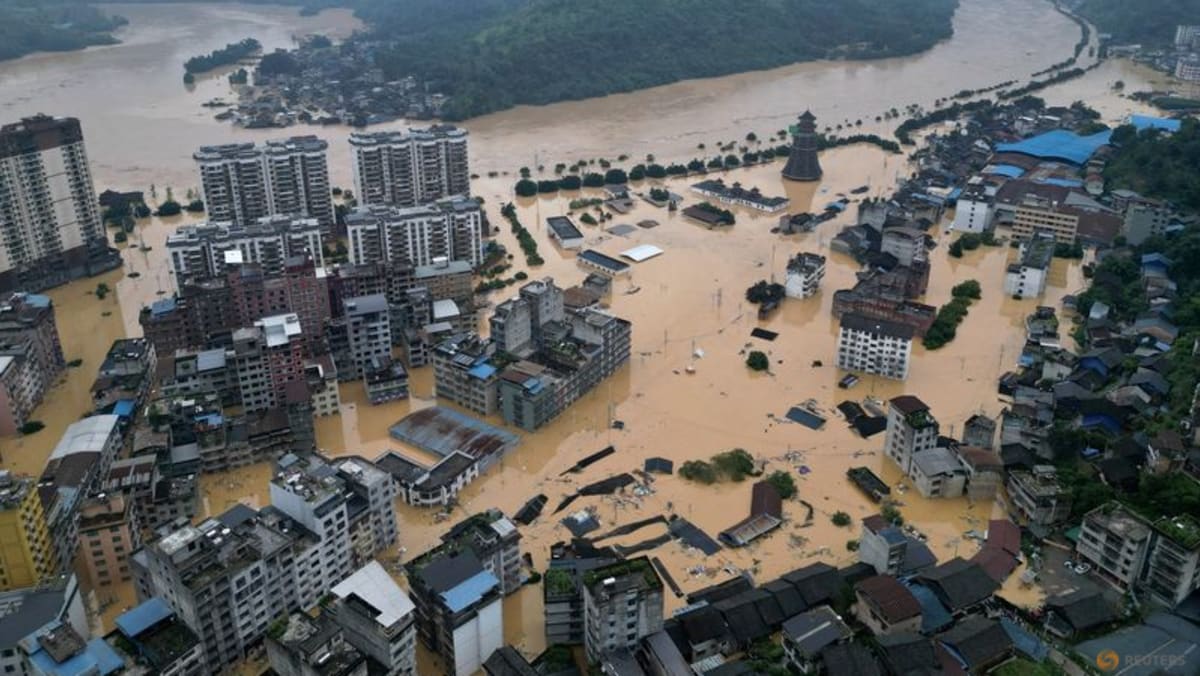China's Expanding Social Safety Net: A Lifeline Amidst Devastating Floods

"China's Expanding Social Safety Net: A Lifeline Amidst Devastating Floods"
In the heart of Beijing, a new chapter unfolds as China fortifies its social security framework to shield its citizens from the relentless onslaught of extreme weather. With the skies unleashing torrents of rain, the nation has pledged to bolster economic protections for those caught in the crossfire of its flood management strategies. This initiative includes direct compensation from the central government and unprecedented payments for livestock losses, marking a significant policy shift.
Flood diversion, a cornerstone of China's strategy to manage downstream flooding, involves redirecting water to designated areas adjacent to rivers. These zones, often dormant and now teeming with farms, croplands, and homes, have become battlegrounds of social tension as the frequency of extreme rainfall escalates. The revised compensation rules, unveiled recently, herald a new era of governmental responsibility. The central government will now shoulder 70% of compensation costs, a stark departure from the previous model where local governments bore a larger burden based on their fiscal health and the extent of economic damage.
In a groundbreaking move, the compensation scheme now encompasses livestock and poultry unable to be evacuated ahead of floodwaters, expanding beyond the previous focus on working animals alone. This policy evolution reflects a deeper understanding of the rural economy's intricacies and the need for comprehensive support.
The summer of 2023 etched a poignant narrative in Hebei province, a region perched on Beijing’s doorstep. Nearly a million residents were uprooted as record-breaking rains forced authorities to divert water from engorged rivers into populated areas, igniting a firestorm of anger over the sacrifice of homes and livelihoods to safeguard the capital. China, with its designated flood diversion areas spanning major river basins like the Yangtze, witnessed significant activations during the Hebei deluge.
Since the onset of the East Asia monsoon in early June, precipitation levels in the Yangtze's middle and lower reaches have increased significantly, as reported by the China Meteorological Administration. This relentless downpour shattered records across provinces such as Hubei and Guizhou, where numerous meteorological stations documented unprecedented rainfall for June.
Guizhou emerged as a focal point of China’s flood mitigation efforts, with one city experiencing a deluge of a magnitude seen only once in half a century. The rapidity of the flooding left its residents reeling, prompting Beijing to vow to relocate vulnerable communities and industries to safer grounds, while expanding flood diversion capacities.
This unfolding saga underscores the delicate balance China must strike between urban protection and rural sacrifice. As climate change intensifies, the nation’s commitment to expanding its social safety net serves as both a beacon of hope and a testament to the challenges ahead.
🔮 Fortellr Predicts
Confidence: 85%
In the coming days, China's proactive response to the widespread flooding in provinces like Guizhou will test the robustness of its newly expanded social safety net. This system is designed to lessen the immediate impact of the floods on affected populations through direct compensation and enhanced emergency responses. In the next 24 hours, ongoing evacuations and relief efforts will be ramped up, particularly utilizing drones and boats to provide essential supplies to isolated areas. The government will continue its critical first-response efforts, deploying medical teams and ensuring emergency shelters are equipped to accommodate the swelling number of evacuees. Over the next 48 hours, we can expect an escalation in weather conditions, particularly in already hard-hit regions, prompting additional flood defenses and possibly international aid requests. These efforts will also see increased political and social media activity emphasizing government accountability and efficacy. By the end of 72 hours, the focus will shift toward strategic preparations for further climate resilience. Long-term strategies will likely prioritize infrastructural improvements and flood mitigation projects as growing evidence of climate change's impact on severe weather patterns becomes undeniable, sparking discussions around sustainable urban planning and agricultural innovation. Key stakeholders, including local governments, agricultural producers, construction industries, and international partners, will remain central to this discourse.